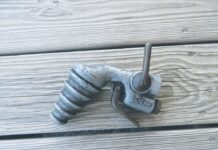Now that trilliums and May apples are up, there’s little doubt that spring is here. Time to take the bird feeders down, right? Not necessarily.
Nyjer, nectar and mealworms are great warm weather foods for a variety of backyard birds. I provide nyjer (also called “thistle”) for goldfinches year round. After nesting, they bring their newly fledged broods to feeders. Unlike most birds, goldfinches eat seeds almost exclusively.
Nectar (one part table sugar, four parts boiling water, mix, cool and refrigerate) attracts hummingbirds, orioles, and a surprising variety of other birds that enjoy a sweet drink. Nectar can also be used to attract a variety of insects that attract a variety of birds.
Insect feeder
An insect feeder is simple to set up. Start with some hummingbird nectar. Add some stale pancake syrup, juice from canned fruit and blend the mixture with a soft, over-ripe banana. Place a small container of this sweet cocktail on a tray feeder.
You may want to put this feeder in a far corner of the yard because it will attract bees and wasps as well as myriad other insects. And shortly after the insects arrive, so will the birds. Virtually all nesting birds feed their nestlings insects (except finches), so expect to see almost any bird at an insect feeder during the nesting season.
Keep in mind that spring migration is underway, so the array of birds that visit will change over the next four weeks.
Even hummingbirds will hover above the slurry and pick off gnats, fruit flies, and other soft-bodied insects. If moving feeders to avoid bees and wasps sounds like too much work, try painting the trunk of a tree with the sweet concoction.
Mealworms
This simulates a natural sap flow and works just as well. Or offer live mealworms. The larval form of darkling beetles, mealworms keep for weeks in the refrigerator, and most birds love them. Offer a small handful in a shallow dish on a tray feeder.
Mealworms are grown commercially for pet and bait shops, but they’re expensive. Two dollars buys just a few dozen. Mail order sources are more economical — 5,000 mealworms for less than $30 ppd. Google “live mealworms” to find more reasonably priced sources.
Better yet, buy a few thousand mealworms and start your own colony. All you need is a large plastic container (a sweater box works well) with a lid, a supply of wheat bran for food, several brown paper bags, and an apple. If you can’t find wheat bran, bran breakfast cereal, rolled oats, or corn meal will suffice. Add about three inches of bran to the container. This is the mealworm food.
Preparing the container
For moisture, slice an apple in half and push each half, flat side down, into the bran. Add about 50 mealworms for each square foot of container. Now cover the entire culture with several sheets of brown paper. The mealworms will move about the layers of paper when not feeding.
Before putting the lid on the container, drill a grid of quarter-inch holes spaced about two inches apart. If condensation forms inside the lid, drill more holes.
Both the mealworms and their food must be kept dry. Store the culture at room temperature. Within a few weeks, some of the mealworms will begin to pupate. The pupae are fleshy, light colored and will ultimately transform into adult darkling beetles.
The adults will then mate, and the females will lay eggs in the bran. Then the adults die. When the eggs hatch, the mealworm life cycle starts anew. Check the culture every few days. When the apple is eaten, replace it. And every three months, clean the container and renew the culture.
Odors
If you detect an unpleasant odor in the container, it’s time to clean it. A healthy mealworm culture has little or no odor. For a virtually limitless supply of mealworms, start several cultures at monthly intervals. Each square foot of culture should yield more than 1,000 mealworms each cycle.
And live mealworms can be stored in a refrigerator for several weeks to prevent pupation.
Send questions and comments to Dr. Scott Shalaway, RD 5, Cameron, WV 26033 or by email via my web site, http://scottshalaway.googlepages.com.












Great article for feeding and looking after your birds, if you are looking for an online shop which sells bird food, feeders and accessories, all supplied direct from our farm at low prices. Vine House Farm support the Wildlife Trusts, and grow as much of our wild bird seed on our conservation award winning farm as possible.